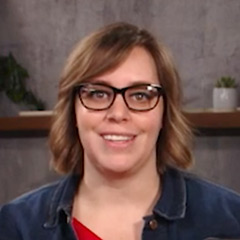
Oiling Out
Katie LiddiardAs a new oil painter, you might have the experience of enjoying a day of painting, thinking your work looks good, and then returning the next day to a canvas that looks dull, hazy, and gray. It happens to everyone, and artist Katie Liddiard is here to explain why it happens and how to bring your painting back to life. Katie shows us a painting she's made that's lost some of its vibrancy, explaining that some colors, especially darker hues, can get sunken into the ground. If you've used an acrylic gesso to prepare your canvas, this tendency for the ground to suck the oil from the pigment can be especially strong. The colors then look disappointingly dull and the painting flat.
It's important to address this, Katie says, so you can continue painting while seeing your intended value range. The process of "oiling out" the painting will revive it. Katie begins by picking up some of her medium with her brush—just a small amount—and adding a touch of mineral spirits in a ratio of about three parts mineral spirits to one part medium. Using the brush, she rubs this mixture on the entire surface of the painting. All of the lost tones and depth of color return! Katie suggests avoiding using too much oil, as it can deteriorate your painting. Next, wipe off the excess with a paper towel (some artists like to use a makeup sponge for this step). Check out your painting at an angle to be sure you didn't miss any spots. Now, paint on!
Have you had a really great painting day in the studio, gone home, relaxed, come back the next day, and it feels like there's a haze over your painting? All the values are off. Everything kind of looks dull and gray. Well, you're not alone. It is kind of a universal problem for most oil painters.
I'm Katie Liddiard, and I'll show you how to work around that and how to bring your painting back to life. So I have this painting here that just kind of feels a little dull. It definitely has the colors there, but there's definitely not the life that I had painted into it originally when it was fresh. What happened was that the especially darker colors, they tend to get what's called sunken into the ground. Mostly, an acrylic gesso is really bad at sucking in that oil from the pigments.
Then what will happen is that the pigments will look like they're really, really dull. All the oil has been sucked out of them from the top layers. So how do you work around this? It's obviously not something that you can just continue on into the painting and paint another day on because you need to be able to adjust and understand your value range within the painting as it stands. So what we do is we oil out.
So I'm gonna grab some of my medium here, just a little bit with a brush. Get it on my canvas. You can see that's not a whole lot, especially for how big my painting is. I don't need a bunch. I'll grab some of my mineral spirits.
The ratio that I like to use is about 3:1, so about three dips into my mineral spirits and one little dip into my medium. It gets nice and soupy. I don't need a whole lot of oil to bring this back to life. What I'll do then is just rub it all over my painting, and you can see an immediate difference how my painting is brought back to life immediately. All of those tones that were lost are right back where they should be.
You can see the depth of the darks that I had in here that had all just kind of disappeared into a gray haze before. Now, what I don't want to do is use too much oil on my painting. Oil is, ironically, the thing that can deteriorate your painting, and so I want to be sure that I'm using the least amount of oil that I need in my painting. So after I get it oiled out, I'm going to take just a paper towel and wipe off any excess. Some people like to use makeup sponges.
It's just a little bit of a softer absorbent thing to get all of that excess oil off. I'll also kind of look at it at an angle to make sure I didn't miss any spots and make sure that everything is just ready to go for me to paint on today. So that's how you oil out, and I hope this helps you in your future paintings.

The name of the medium was covered by the recording’s progress bar at the bottom of the video and there was no way to turn it off. She never actually named the medium so I don’t know what it is.
Hi Katie, as oil paint takes a while to dry, how long should you wait before doing this process? I'd be concerned the paint will smudge. Also, you mentioned using acrylic gesso could be a problem. What would you recommend instead? Thanks, Cris
Would this be a problem for water based oils? If so, would you fix it the same way? Thanks.